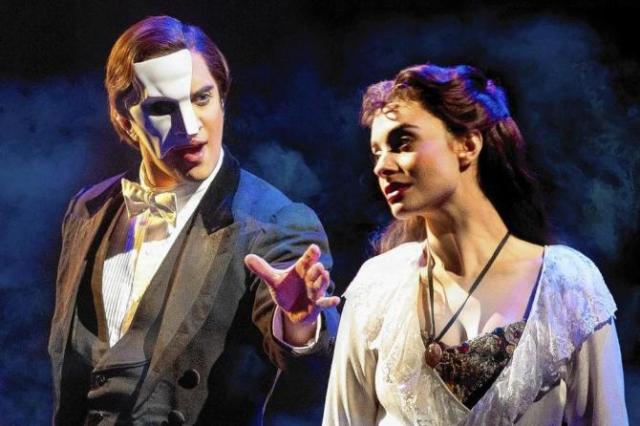
This summer marks the Phantom of the Opera’s first appearance since 2009. Better yet, Milwaukee gets an early look at this restaged version of the best-selling and longest-running show in Broadway history (in fact, it’s still running). The “new” version has some strong points, including a tightened script (the show has been shortened by 15 minutes) and a more fluid approach. By this, one means that there is rarely a “static” moment in which the characters are merely standing around, trading dialogue. One sees movement everywhere. The best example of this is the “Masquerade” number which opens Act II. The huge staircase is gone, allowing the characters to glide and twirl across the stage. In a nod to A Chorus Line, “antiqued” mirrors have been placed behind and above the dancers, in order to add depth to the staging. It is quite pretty to watch, and it does a better job of conveying what needs to happen in this scene.
However, if longtime Phantom fans are going to miss the glorious staircase at the top of Act II, they will be downright discouraged by some of the production’s other changes. The show’s gasp-inducing scene, in which the Phantom puts Christine into a gondola and glides it across a “lake” filled by flaming candelabras, is gone. Yes, there is a brief boat ride, but, sadly, it does not pack the wallop of the original effect. But first, the pair must walk down a moving stone silo, where steps appear and disappear at the Phantom’s command. The silo is a nifty set piece. Later, it resumes spinning to reveal subsequent scenes, such as those in the opera’s administrative office. Also on the plus side, the crashing chandelier now comes later in the show. It’s not nearly as well executed as one sees on Broadway or (formerly) in Las Vegas, but at least it doesn’t “waste” one of the show’s most memorable effects in its first few minutes.
Other changes are somewhat clumsy, such as the backstage carpenter’s hanging. The Phantom is seen actually tying the knot around the man’s neck, as if we couldn’t figure out who was responsible for his death. Somewhat more unsettling is a new twist in the Phantom’s appearance. No longer an older, father figure (which Christine clearly yearns for, since her own father’s death), the Phantom is now a strapping young man, agile and handsome (on one side of his face, at least). His prey is Christine, a young, talented singer at the opera house. The Phantom’s transformation makes his sexual intentions clearer as he tries to lure Christine away from Raoul, a rival. The Phantom also seems less dark and maniacal. This makes Christine’s crucial decision between the men almost a given, since they are practically on the same footing.
Thankfully, the “new” version doesn’t skimp on size, spectacle or sparkle. A large cast and 14-piece orchestra (under the musical direction of Richard Carsey, a longtime presence on Milwaukee’s music scene) remain impressive. The costuming remains glorious. The full, rich sound of Andrew Lloyd Webber’s music comes across with precision.
Best of all, the cast demonstrates considerable vocal talents. The show begins with perfectly pitched notes by the opera’s resident diva, Carlotta (played to the hilt by Jacquelynne Fontaine). Carlotta seems only about 10 years older than the ingénue, Christine (foreshadowing the fleeting fame of performers). Thankfully, Fontaine gets plenty of opportunity to demonstrate her considerable vocal talents. This is also true of the opera’s tenor, Ubaldo (Frank Viveros), who is almost as much a drama queen as Carlotta. The opera’s new and unschooled owners (Brad Oscar and Edward Staudenmayer) are played with a bit more humor and finesse than seen in previous productions. The “mother terrorist” Madame Giry, who keeps her young ballet corps in check, is brilliantly played by Linda Balgord. Christine, the main character, is impressively handled by 20-year-old Julia Udine. She seems just as impressionable, naïve and confused as one would expect of someone Christine’s age. Udine’s voice is bright and clear, and it soars with the optimism of youth. If anything, this Christine seems more in control of her destiny than one typically sees. She doesn’t seem to “fall” as easily for Phantom’s hypnotic power (possibly because the Phantom’s underground lair has been scaled-down in size. It’s not nearly creepy enough so that one can identify with Christine’s terror.)
Raoul, the childhood friend who attempts to steal Christine away from the Phantom’s grasp, appears in the nick of time. As Raoul, Ben Jacoby makes such a positive first impression that one wonders why it takes Christine so long to make her choice. (But then, the story wouldn’t stretch to 2 ½ hours, right?) Jacoby’s voice ranks up there with the rest of the principals.
Cooper Grodin plays the Phantom with less beguiling charm and more testosterone than usual. He, too, is no slouch in the singing department. New technology allows the Phantom to pull off some stage tricks that, frankly, are more suited to a heavy metal rock concert than a Broadway show. For an evening of gorgeous singing, delicious dancing, a strong story and the robust sound of a full orchestra, it would be hard to beat this “new” The Phantom of the Opera.
